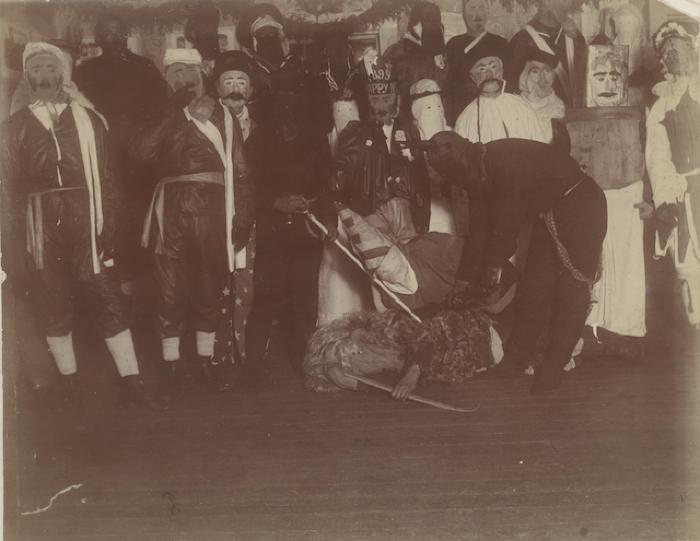New Year’s Play — Nuuwikuutarluni

For over a century, the Alutiiq New Year’s play was a Kodiak holiday tradition. Today, the residents of Nanwalek and Port Graham continue to stage this comical show, but it has not been performed on Kodiak for years. Introduced to Alaska by Russian immigrants, the show is the final event in the celebrations surrounding Russian Christmas. Anthropologist Craig Mishler suggests that its deep roots are in Western Ukrainian traditions. However, the Alutiiq version has its own unique character with links to Native traditions.
The play has no script, no speaking parts, and no rehearsals. People learn the action by watching and volunteering to participate. About eighteen actors play the parts of the Old Year, the New Year, the months of the year, a group of old ladies, and a policeman. Musicians accompany the twelve-act show which lasts about two hours.
The play is about the change of years, with the New Year ushering out the old. The Old Year wants to dance with each month as he leaves. The old ladies are envious and disrupt the dancing. These comical, unruly characters, typically played by men dressed as women, improvise as much confusion as possible. They interrupt the dancing and work the audience. A policeman scolds the ladies and tries to usher them out, while the New Year beats the Old Year with a wooden paddle. At midnight the drama ends with a gunshot and one last dance by the entire cast. Then everyone unmasks and sings the hymn Many Years. The final step is purification. Audience members and actors wash away their sins with a church service, a steam bath, or an ocean plunge.
The New Year’s play can be seen as a masked dance. It is reminiscent of winter festivals, performances where dancers called upon the spirit world for help renewing the year. In the play, all of the actors hide their faces with a mask or a veil. Moreover, the old ladies’ costumes often include beaks and feathers. Bird imagery was a common element of ceremonial masks because birds are powerful creatures that can traverse every layer of the universe – the sky, the land, and the water. This suggests that the ladies may be spirits. Mishler points out that sometimes they are referred to as devils.
